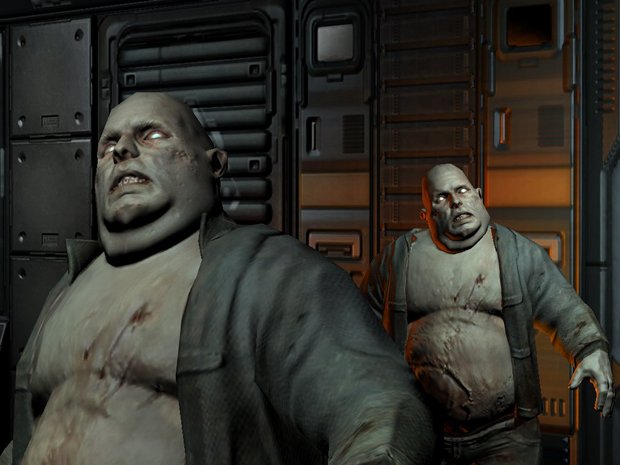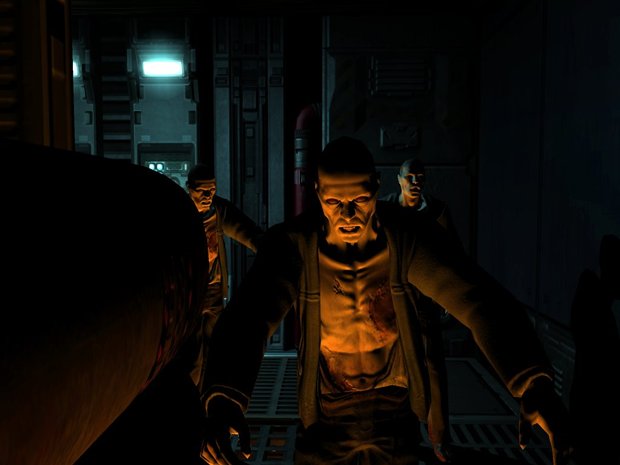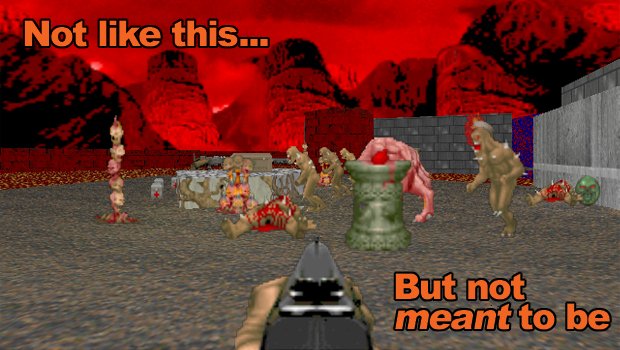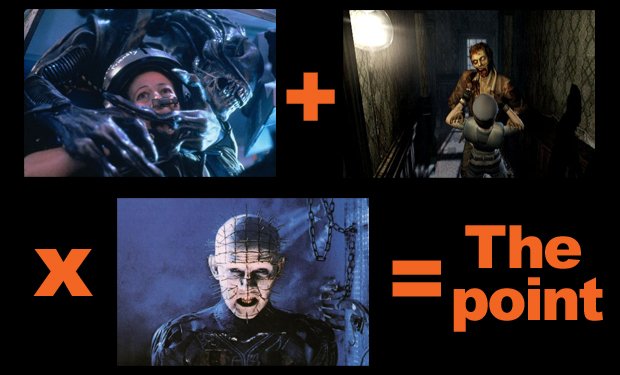The classic game appreciation section: Doom 3
It's not the Doom you remember, but it's the Doom you'll never forget

Doom 3 then. Too dark. Too claustrophobic. Too many corridors. Not enough carnage. Closet monsters, closet, monsters, closet monsters. And that torch-or-gun mechanic is cheap as hell. That’s the accepted wisdom of much of the internet these days. But you know what? Much of the internet is full of crap. Yes, Doom 3 has some flaws. Yes, it’s very different from the Dooms of old. But taken on its own terms, it’s also a blistering, nerve-pounding, brutally affecting thrill-ride, one that got under myskin like few other games before it,andhad the scare-power to turnmy very own home into a nightmarish domain of half-seen horrors, ambiguous noises, and thick, black shadows that absolutely, resolutely didwant to kill me as soon as the sunwent down. But you know, in a good way.
So follow me, if you will, through the mists of time, and let me recount to you just why Doom 3 is so special.
Ugly-Beautiful
Every so often, a game appears and shakes your whole perception of what the medium can do the very first second you clap eyes on it. Obviously, such an immediate response usually comes by way of massive technical evolution, such as a vast visual leap forward, or a previously unimagined game mechanic. Super Mario World. Virtua Fighter. Super Mario 64. Half-Life 2. All of these games have done it. All of them have at some point given me the feeling that I’d found myself transported forward through time and was somehow fortunate enough to be playing the games of the very future. And Doom 3 did it too. Very few games have since, actually. Probably only Portal, and maybe Gears of War. Shame really, but I suppose technical advancement is slowing down a bit at the moment.

Anyway, back to the point. Doom 3. The debut of the id Tech 4 engine. Ho. Lee. Shit. When the first magazine screenshots of Doom 3 started appearing, I just didn’t believe it. No-one did. And I’m not just talking about the figurative, hyperbolic meaning of “unbelievable” here. When we first saw what Doom 3 looked like, there was a genuine sense that games like that were just implausible. Obviously id Software's John Carmack has a deserved reputation as the most powerful coding wizard-ninja in the industry, but even for him, this was a staggering achievement.
Stunningly believable bump-mapped textures made every monster and wall surface look utterly real, down to the last perfect imperfection. Staggeringly dense and lifelike unified lighting and shadows gave every object and character in every environment a tangible physicality and sense of place and belonging that we’d never seen before.

The future was here, and boy was it scary. And the fact that Doom, the undisputed leader of the original FPS revolution, was the game bringing it felt really rather perfect. And all of this was before I’d even played a second of Doom 3. When I had… Oh good Lord…
Slow down, pace yourself
Doom 3’s greatest success is the thing that most of its detractors cite as its biggest disappointment. But they’re wrong. They have an entirely justifiable argument, coming from their own perspective, but the fact is that they’re coming at Doom 3 from the wrong angle.
Weekly digests, tales from the communities you love, and more

Slower, creepier, and far more claustrophobic than Doom and Doom II, Doom 3 is an altogether different beast. Perhaps (in fact probably) lead somewhat by a desire to properly show off what id Tech 4 could do, it’s an atmospheric, oppressive, deliberately-paced horror show, punctuated with bursts of extreme violence and dusted with spine-cracking tension throughout. Go in with no preconceptions, no expectations of the open environments and huge swathes of circle-strafed bullet fodder of the Dooms of old, and on its own merits Doom 3 is a bit of a stunner.
Neatly straddling the ground between the bullet-spewing action-horror of Aliens and the claustrophobic, resource-juggling hardships of Resident Evil, Doom 3 is a punishing and smartly-designed journey of emotional manipulation. You’ll suffer long periods of quiet terror, in empty corridors with an empty bullet chamber. But then you’ll find yourself almost immediately detonating flesh and bone in every direction in an initially shocking but ultimately cathartic maelstrom of brutal arse-kickery. But then you’ll calm down and let the dust settle. You'll get your breath back. And then you’ll realise that the chamber is empty again. And then you’ll realise that you can hear something rumbling in the shadows.

The source of that rumble t might be right behind you. It might be in the next room. It might be in the ceiling immediately above you. It might just be a power generator. But you’ll reload with whatever you have left, and you’ll go on a hunt. And it’ll be a very bloody cautious hunt indeed.
Doom 3 isn’t, as many complained, a case of id Software losing sight of its roots. It’s the product of a smarter, more nuanced, modern id bringing all the impact of its considerable long-standing skill-set to a modern, affecting narrative experience. Take the opening stages of the game for instance. They’re bloody brilliant.
Taking a leaf from the Half-Life 2 book of story exposition, Doom 3 starts out with a long, slow-burning introduction to the Mars of the 23rd century. Certainly not what many expected from any entry in the Doom series, but good God, did that first half-hour make everything that followed so much more impactful. Dizzyingly so. In fact I still put it down as one of the best openings in game history. Seriously, it had my head spun-out for days.
Landing at the UAC Mars base as a staff transfer, the sense of time and place is immediately intoxicating, just as engaging and disorienting for you as it would be for the nameless marine you play. The initial loading bay setting is abuzz with activity. Machinery hums, engines roar, workers go about their business, and automated audio and video messages bombard your senses with UAC PR messages from every direction. But underneath the audio-visual assault, if you stop to listen, you’ll hear something else...
So follow me, if you will, through the mists of time, and let me recount to you just why Doom 3 is so special.
Ugly-Beautiful
Every so often, a game appears and shakes your whole perception of what the medium can do the very first second you clap eyes on it. Obviously, such an immediate response usually comes by way of massive technical evolution, such as a vast visual leap forward, or a previously unimagined game mechanic. Super Mario World. Virtua Fighter. Super Mario 64. Half-Life 2. All of these games have done it. All of them have at some point given me the feeling that I’d found myself transported forward through time and was somehow fortunate enough to be playing the games of the very future. And Doom 3 did it too. Very few games have since, actually. Probably only Portal, and maybe Gears of War. Shame really, but I suppose technical advancement is slowing down a bit at the moment.

Anyway, back to the point. Doom 3. The debut of the id Tech 4 engine. Ho. Lee. Shit. When the first magazine screenshots of Doom 3 started appearing, I just didn’t believe it. No-one did. And I’m not just talking about the figurative, hyperbolic meaning of “unbelievable” here. When we first saw what Doom 3 looked like, there was a genuine sense that games like that were just implausible. Obviously id Software's John Carmack has a deserved reputation as the most powerful coding wizard-ninja in the industry, but even for him, this was a staggering achievement.
Stunningly believable bump-mapped textures made every monster and wall surface look utterly real, down to the last perfect imperfection. Staggeringly dense and lifelike unified lighting and shadows gave every object and character in every environment a tangible physicality and sense of place and belonging that we’d never seen before.

The future was here, and boy was it scary. And the fact that Doom, the undisputed leader of the original FPS revolution, was the game bringing it felt really rather perfect. And all of this was before I’d even played a second of Doom 3. When I had… Oh good Lord…
Slow down, pace yourself
Doom 3’s greatest success is the thing that most of its detractors cite as its biggest disappointment. But they’re wrong. They have an entirely justifiable argument, coming from their own perspective, but the fact is that they’re coming at Doom 3 from the wrong angle.

Slower, creepier, and far more claustrophobic than Doom and Doom II, Doom 3 is an altogether different beast. Perhaps (in fact probably) lead somewhat by a desire to properly show off what id Tech 4 could do, it’s an atmospheric, oppressive, deliberately-paced horror show, punctuated with bursts of extreme violence and dusted with spine-cracking tension throughout. Go in with no preconceptions, no expectations of the open environments and huge swathes of circle-strafed bullet fodder of the Dooms of old, and on its own merits Doom 3 is a bit of a stunner.
Neatly straddling the ground between the bullet-spewing action-horror of Aliens and the claustrophobic, resource-juggling hardships of Resident Evil, Doom 3 is a punishing and smartly-designed journey of emotional manipulation. You’ll suffer long periods of quiet terror, in empty corridors with an empty bullet chamber. But then you’ll find yourself almost immediately detonating flesh and bone in every direction in an initially shocking but ultimately cathartic maelstrom of brutal arse-kickery. But then you’ll calm down and let the dust settle. You'll get your breath back. And then you’ll realise that the chamber is empty again. And then you’ll realise that you can hear something rumbling in the shadows.

The source of that rumble t might be right behind you. It might be in the next room. It might be in the ceiling immediately above you. It might just be a power generator. But you’ll reload with whatever you have left, and you’ll go on a hunt. And it’ll be a very bloody cautious hunt indeed.
Doom 3 isn’t, as many complained, a case of id Software losing sight of its roots. It’s the product of a smarter, more nuanced, modern id bringing all the impact of its considerable long-standing skill-set to a modern, affecting narrative experience. Take the opening stages of the game for instance. They’re bloody brilliant.
Taking a leaf from the Half-Life 2 book of story exposition, Doom 3 starts out with a long, slow-burning introduction to the Mars of the 23rd century. Certainly not what many expected from any entry in the Doom series, but good God, did that first half-hour make everything that followed so much more impactful. Dizzyingly so. In fact I still put it down as one of the best openings in game history. Seriously, it had my head spun-out for days.
Landing at the UAC Mars base as a staff transfer, the sense of time and place is immediately intoxicating, just as engaging and disorienting for you as it would be for the nameless marine you play. The initial loading bay setting is abuzz with activity. Machinery hums, engines roar, workers go about their business, and automated audio and video messages bombard your senses with UAC PR messages from every direction. But underneath the audio-visual assault, if you stop to listen, you’ll hear something else...



